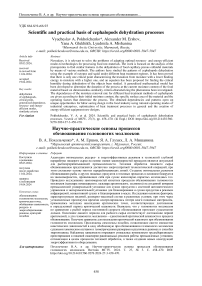Scientific and practical basis of cephalopods dehydration processes
Автор: V. A. Pokholchenko, A. M. Ershov, Ya. A. Glukhikh, L. A. Mishanina
Журнал: Вестник Мурманского государственного технического университета @vestnik-mstu
Рубрика: Процессы и аппараты пищевых производств
Статья в выпуске: 3 т.27, 2024 года.
Бесплатный доступ
Nowadays, it is relevant to solve the problems of adapting optimal resource- and energy-efficient modes to technologies for processing food raw materials. The work is focused on the analysis of the prerequisites to find similar features in the dehydration of food capillary-porous colloidal materials by means of various methods. The authors have studied the patterns of cephalopods dehydration using the example of octopus and squid under different heat treatment regimes. It has been proved that there is only one critical point characterizing the transition from moisture with a lower binding energy to moisture with a higher one, and an equation has been proposed for finding the critical humidity during dehydration of the objects been studied. A generalized mathematical model has been developed to determine the duration of the process at the current moisture content of the food material based on dimensionless similarity criteria characterizing the phenomena been investigated. The dependences of the moisture removal rate for different heat treatment methods of cephalopods are given according to their initial moisture content, the specific surface area of the material and the operating factors that determine the process. The obtained dependencies and patterns open up unique opportunities for labor-saving design in the food industry using rational operating modes of industrial enterprises, optimization of heat treatment processes in general and the creation of energy-efficient equipment new designs.
Dehydration of cephalopods, critical point, generalized dependence, resource- and energy-efficient modes, similarity criteria, обезвоживание головоногих моллюсков, критическая точка, обобщенная зависимость, ресурсо- и энергосберегающие режимы, критерий подобия
Короткий адрес: https://sciup.org/142241960
IDR: 142241960 | УДК: 664.8/.9+66-93 | DOI: 10.21443/1560-9278-2024-27-3-458-470
Текст статьи Scientific and practical basis of cephalopods dehydration processes
Pokholchenko, V. A. et al. 2024. Scientific and practical basis of cephalopods dehydration processes. Vestnik of MSTU, 27(3), pp. 458–470. (In Engl.) DOI:
e-mail: , ORCID:
Похольченко В. А. и др. Научно-практические основы процессов обезвоживания головоногих моллюсков. Вестник МГТУ. 2024. Т. 27, № 3. С. 458–470. DOI:
Heat treatment of food raw materials by dehydration seems to be a rather energy-consuming technological operation. It also forms the basis of many processing lines. Processes and technologies with minimal energy, labor and resources are in great demand in modern conditions. This ensures a reduction in the cost of finished products and increases the efficiency of the use of technological equipment. The development of such processes and technologies is possible based on knowledge of the patterns of their flow and obtaining generalized dependencies.
A significant contribution to the research and development of approximate methods for calculating dehydration processes based on the general patterns of their course was made in the last century by well-known researchers Lykov A. V., Ginzburg A. S. and others ( Ginzburg et al., 1982; Lykov, 1968 ). Their work is based on the application of similarity theory. This theory shows the similarity of phenomena with the ratio of interacting factors characterized by similar values of similarity criteria. The processes are characterized by similarity equations with some dimensionless criteria in the established relationships among themselves. The dependence with several certain similarity criteria in such phenomena can be considered a mathematical model of the process.
The creation of optimal modes for fish and other food products dehydration in thermal processes is mainly based on the patterns that reveal during drying of capillary-porous colloidal bodies ( Ginzburg et al., 1982; Lykov, 1968 ). The solution of differential equations of heat and mass transfer was carried out mainly under boundary conditions of the first kind ( Bellegha et al., 2002; Mwithiga et al., 2004; Chavan et al., 2008; Ortiz et al., 2013; Pogonets, 2016; Lekrati et al., 2021 ) although often the heat treatment of hydrobionts occurs under boundary conditions of the third kind.
A lot of researches are devoted to the study of the water activity coefficient which depends on the degree of dehydration of fish or other food products ( Fu et al., 2007; Vega-Gálvez et al., 2009; Voronenko et al., 2009; Uribe et al., 2011; Ozuna et al., 2014 ).
In the works devoted to the study of food dehydration processes, various methods of generalization of dehydration kinetics curves can be noted ( Bellegha et al., 2002; Yuvanaree et al., 2004; Chavan et al., 2008; Shi et al., 2008; Uribe et al., 2011; Ortiz et al., 2013; Ozuna et al., 2014 ). However, for the fishing industry, the above methods have limited application, and their use does not contribute to the identification of general patterns of heat and mass transfer in raw materials under various modes and methods of energy supply.
Scientists have developed several methods for calculating the kinetics of dehydration based on general patterns of processes to reduce the number of experiments ( Ginzburg et al., 1982; Shi et al., 2008; Vega-Gálvez et al., 2009; Ershov, 1992; Pokholchenko et al., 2015, 2020, 2022 ).
Generalizing the dehydration kinetics curves based on dimensionless similarity criteria has been proposed. A clear relationship has been established between critical moisture on the dehydration kinetics curves and the chemical composition of fish. The second critical point on the dehydration kinetics curve occurs when microcapillary moisture is removed. At the same time the binding energy of moisture in fish increases with dehydration and the size of capillaries decreases significantly, especially in the near-surface layers ( Ershov, 1992 ; Glazunov et al., 2013; Pokholchenko et al., 2015, 2020, 2022 ).
The authors have previously proposed mathematical models of the kinetics of dehydration of fish raw materials under the influence of a thermal agent in the temperature range from 40 to 180 °C in the processes of semi-hot, hot drying, drying and roasting ( Glazunov et al., 2013; Pokholchenko et al., 2015 ).
However, there is insufficient information for the computational and analytical design and heat treatment processes optimization for non-fishery species, such as cephalopods, submitted mainly only by partial dependencies. The proposed methods have limited application and their use does not contribute to identifying the general patterns of heat and mass transfer in a raw material under different modes and energy supply methods ( Yuvanaree et al., 2004; Fu et al., 2007; Valencia-Pérez et al., 2008; Vega-Gálvez et al., 2009; Kucherenko et al., 2010; Uribe et al., 2011; Deng et al., 2014; Wang et al., 2014; Pogonets, 2016; Zhao et al., 2017; Blagonravova et al., 2021; Lekrati et al., 2021 ).
It is necessary to examine the nature of moisture removal under different modes and methods of energy supply. It should be done in order to work out a generalized model of the cephalopods dehydration process, to identify the availability and number of critical points that characterize changes in the ways of moisture and the material connection. It is necessary to estimate the possibility of using previously obtained generalized dependencies for fish raw materials when designing dehydration processes for non-fishery species. The range of criteria for various methods of their heat treatment in a generalized model should also be worked out.
Materials and methods
The processes of cephalopods dehydration have been worked out. Frozen raw materials: squid commander, squid Argentine, octopus were used as objects of heat treatment. Kinetic dependencies have been studied taking into consideration the influence of each determining factor on the nature of the process separately. The experiments were grouped in series, in each of them the studied factor affecting the process was changed within the specified limits. The remaining factors were kept constant over time.
The influence of factors characterizing the species, size and mass composition and regime conditions is investigated. Moisture loss of food material was controlled by the standard method at regular intervals.
The experimental part of kinetics processes research of the cephalopod’s dehydration was carried out on an industrial universal plant created and tested to produce dried, smoked hydrobionts in wide temperature ranges (Fig. 1). The installation is equipped with a hardware and software complex. The automatic control system is implemented based on a controller and consists of four separate units (Fig. 1). The installation is used to work out energy-efficient modes of products dehydration and the release of small batches of dried and smoked products ( Glazunov et al., 2013 ).
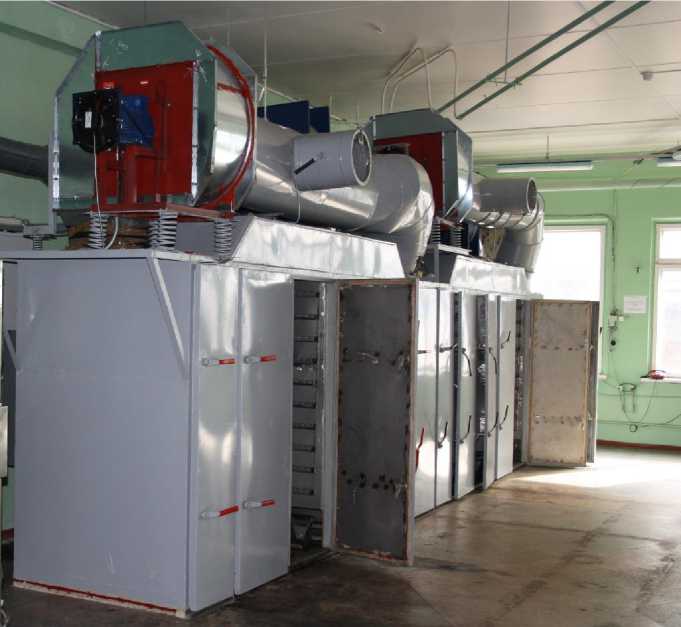
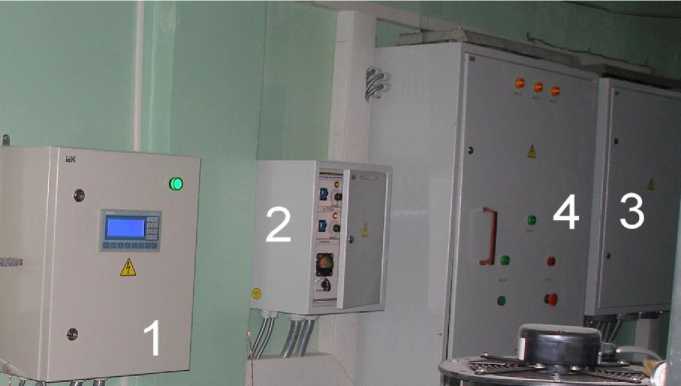
Fig. 1. Universal unit for drying and smoking products with automatic control system:
1 – automatic control unit; 2 – manual control unit; 3 – power unit; 4 – distribution unit ( source: compiled by the authors )
Рис. 1. Универсальная установка для сушки и копчения продуктов с системой автоматического управления: 1 – блок автоматического управления; 2 – блок ручного управления;
3 – силовой блок; 4 – распределительный блок ( источник: составлено авторами )
Some of the experiments were carried out on an experimental laboratory installation adapted for the combined process of blanching and drying products (Fig. 2).
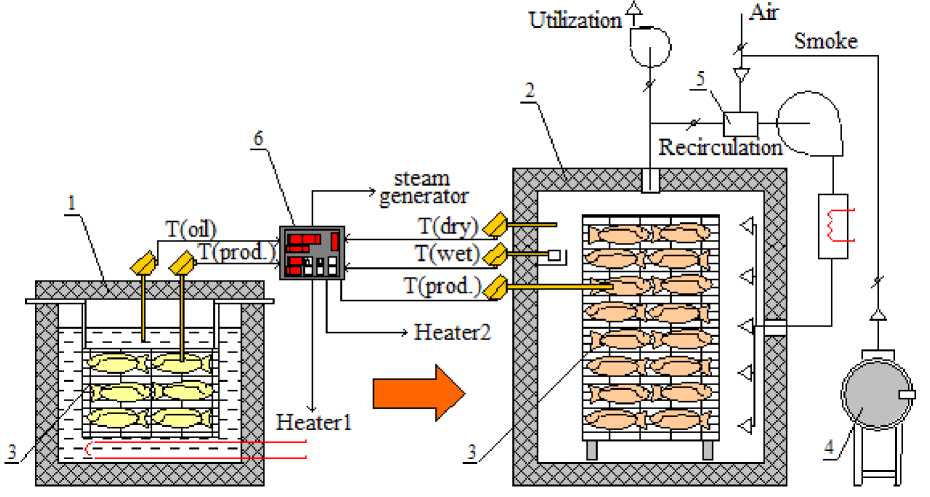
Fig. 2. Experimental installation for blanching and drying products:
1 – blanching treatment unit; 2 – drying chamber; 3 – grids with processing objects;
4 – smoke generator; 5 – drying agent mixing unit; 6 – controller ( source: compiled by the authors ) Рис. 2. Экспериментальная установка для бланширования и сушки продуктов:
1 – блок обработки бланшированием; 2 – камера обезвоживания сушкой; 3 – сетки с объектами обработки; 4 – генератор дыма; 5 – блок смешивания тепловых агентов; 6 – контроллер ( источник: составлено авторами )
The technique of finding critical points corresponding to the achievement of critical moisture coki in a certain period тki has been used in the research. The technique consists of the dehydration kinetics curves construction in semi-logarithmic coordinates. They are seen as broken lines from a curve and two or three straight lines (Ershov, 1992; Pokholchenko et al., 2015; 2022). To establish generalized patterns and mathematical modeling of heat treatment processes, methods of similarity theory were used (Glazunov et al., 2013) to find the similarity of the phenomena under research based on the definition of dimensionless criteria-simplices of the form:
= const,

т 1 т 1 т n т n
---=---
T ( k 1 ) 1 T ( k 2 ) 1 T ( k 1 ) n T ( k 2 ) n
Results
The kinetics of the processes of dehydration of non-fishing objects – cephalopods as the example of squids and octopuses under various modes and methods of heat treatment has been studied.
It is well known that the dehydration of food materials during the process is accompanied by transitions from moisture with a lower binding energy to that with a higher one. At the same time, the kinetics curves of dehydration of wet materials contain critical points corresponding to transitions between various forms of moisture-substance bonding. There can be from one to several such critical points on the dehydration kinetics curves ( Ershov, 1992; Glazunov et al., 2013; Lykov, 1998; Pokholchenko et al., 2015, 2022 ). For example, during the dehydration of fish raw materials, the presence of two critical moistures was established regardless of the nature of the thermal effect on the processing object. The critical moistures ro k 1 and ro k 2 with sufficient accuracy for engineering calculations are described by the following equations ( Ershov, 1992 ):
юи= 1.069^0.969, (1)
o k2 = 0.784 ffl 0 + 2, (2)
where ro 0 is the initial moisture content in the material, expressed in terms of dry matter, %.
The critical moisture during dehydration of fish raw materials generally depends only on its initial moisture content as can be seen from expressions (1) and (2).
Initially the task was to identify how many critical points arise during the dehydration of such capillary-porous colloidal food materials as cephalopods (Fig. 3). It was also necessary to clarify whether it was possible to apply the patterns obtained by the authors earlier in the research. It was devoted to the processes of fish raw materials dehydration in various ways modeling the thermal processes of cephalopods treatment (Glazunov et al., 2013; Pokholchenko et al., 2015; 2020).
The processes of shredded Argentine squid ( Illex argentines ) infrared drying with an initial moisture content of 74.0 % for total mass, an average initial mass 0.25 ± 0.01 kg of specimen, a mantle length of 0.21 ± 0.01 m at a temperature of 90 up to 110 ± 1 °C with a specific load on the drying meshes from 2.7 to 6.0 kg/m2 (Fig. 3, a ) have been researched.
The process of blanching octopuses ( Octopus vulgaris ) with an initial moisture content of 81.6 % total weight and a specific surface area of 0.26 to 0.33 m2/kg was carried out in vegetable oil heated to a temperature of 120 ± 2 °C. In this case, a semi-finished product partially dehydrated by blanching was obtained for the production of canned delicacies (Fig. 3, b ).
Commander squid ( Berryteuthis magister ) dehydration with an initial moisture content of the 79.5 % total weight, specific surface area from 0.18 to 0.23 m2/kg was carried out by convective treatment by air semi-hot drying at a drying agent temperature from 65 to 80 ± 1 °C, relative air humidity 40 ± 2 % and air circulation speed 4.0 ± 0.5 m/s (Fig. 3, c ). The dried semi-finished product was then sent for shredding and canning.
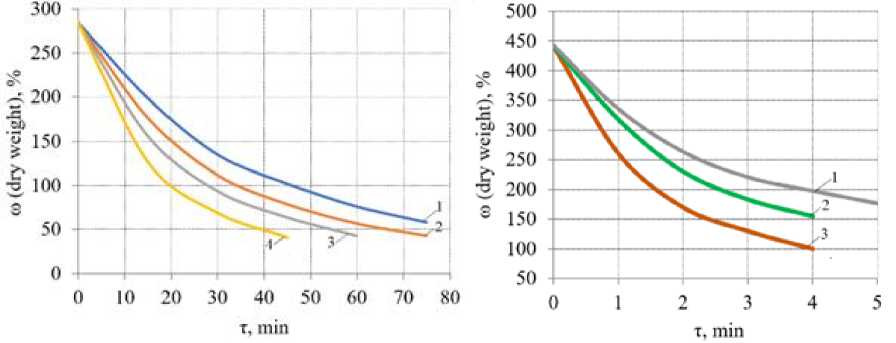
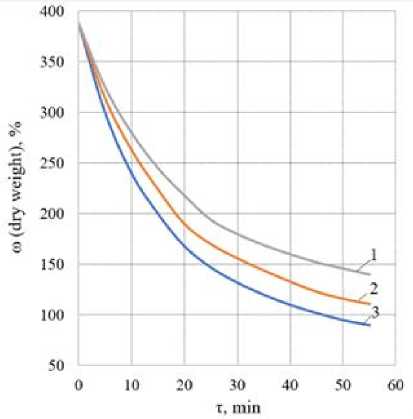
Fig. 3. Kinetics curves of cephalopods dehydration under various modes of heat treatment:
a – infrared drying shredded squid at a specific load on the carrier: 1 – 6.0; 2 – 4.7; 3 – 4.0; 4 – 2.7 kg/m2;
b – blanching octopus in vegetable oil with a specific surface: 1 – 0.26; 2 – 0.30; 3 – 0.36 m2/kg;
c – semi-hot convective drying squid with a specific surface: 1 – 0.18; 2 – 0.21; 3 – 0.23 m2/kg ( source: compiled by the authors )
Рис. 3. Кривые обезвоживания головоногих моллюсков при различных режимах тепловой обработки: a – инфракрасная сушка шинкованного кальмара с удельной нагрузкой на носитель:
1 – 6,0; 2 – 4,7; 3 – 4,0; 4 – 2,7 кг/м2; b – бланширование в растительном масле осьминога с удельной поверхностью: 1 – 0,26; 2 – 0,30; 3 – 0,36 м2/кг; c – конвективная полугорячая сушка кальмара с удельной поверхностью: 1 – 0,18; 2 – 0,21; 3 – 0,23 м2/кг ( источник: составлено авторами )
The patterns are the partial kinetic dependencies of the dehydration processes of the Argentine squid during its processing by infrared drying on conveyor grids (Fig. 3, a ) also octopus during its blanching in vegetable oil (Fig. 3, b ) as well as commander squid under conditions of convective treatment by semi-hot drying (Fig. 3, c ).
As can be seen from the kinetics curves of cephalopods dehydration, regardless of the thermal action method on the processed material the nature of the processes is identical. At the same time, the rate of dehydration increases with a decrease in the specific load on the carriers or an increase in the specific surface of the processing objects (Fig. 3).
In order to identify critical moisture, the dehydration kinetics curves were transferred to semi-logarithmic coordinates of the form lg ro i = f( т i ). Graphs in this form for the analysis of the process can be considered as broken straight lines. Fig. 4 shows an example of a squid dehydration kinetics curve constructed in a semi-logarithmic anamorphosis.
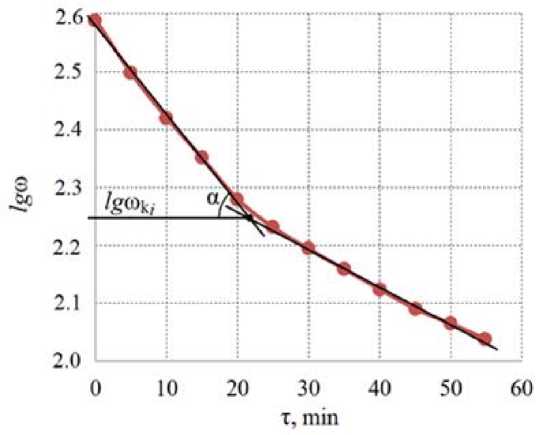
Fig. 4. Squid dehydration kinetics curve in semi-logarithmic coordinates ( source: compiled by the authors )
Рис. 4. Кривая кинетики обезвоживания кальмаров в полулогарифмических координатах ( источник: составлено авторами )
Mathematical processing of semi-logarithmic dependencies lg ro i = f ( т i ) allowed us to determine critical points for a set of dehydration curves of cephalopods. The presence in all studied cases only one critical moisture ro ki to find which the linear regression relationship is proposed
юй = 0.0914268. (3)
The research suggested the generalizing of the cephalopods dehydration kinetics curves with completely different methods of energy supply.
In order to generalize the cephalopods dehydration kinetics curves, the decision was made to use dimensionless similarity numbers (criteria – simplexes) of the species
ГО = f 1 . (4)
И ki \. T ki )
Many particular cephalopods dehydration kinetics curves under various methods and modes of heat treatment were combined into one generalized curve (Fig. 5).
As can be seen from Fig. 5, the partial kinetics curves of cephalopods dehydration with different methods of energy supply can be described by one generalized dependence. Having used the data processing Datafit 9.1.32 mathematical description of the nonlinear regression dependency with the use of non-dimensional simplices is proposed
/ x - 1.158
I 1
—^ = 2.296 1 1 + -i- I . (5)
ro k l т ki)
For dependency (5) Fisher criteria is 5273, the significance of the numerical coefficients is 99.9 %, which generally indicates a significant relationship between the variables in the equation.
Dependency (5) can be used in technological calculations to determine the current (final) moisture cephalopods in the process of dehydration
CO; = 2.296 -й;.

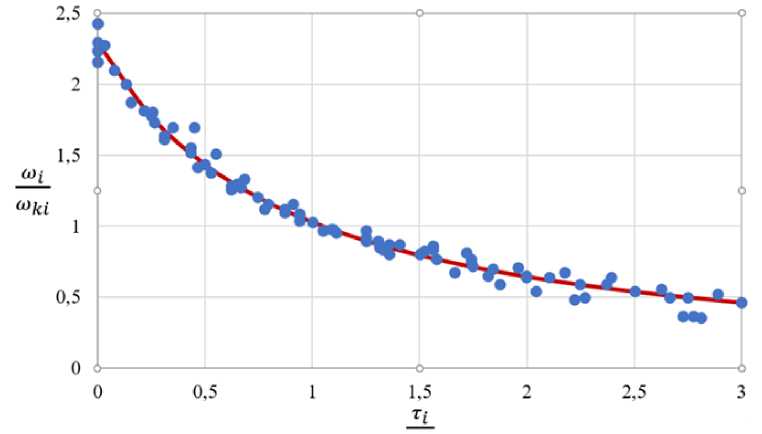
Fig. 5. Generalized kinetics curve of cephalopods dehydration ( source: compiled by the authors )
Рис. 5. Обобщенная кривая кинетики обезвоживания головоногих моллюсков ( источник: составлено авторами )
The duration of the current (final) cephalopods moisture achievements can be determined from the expression (4) in the form of the following formula
T i
= T ki
2.049

— 1
Discussion
The creation of computational methods for optimizing thermal processes is particularly in demand in food engineering while adapting and implementing energy- and resource-saving technologies. Nowadays the supply of cephalopods to coastal enterprises has decreased due to restrictions on fishing for the main producing countries. Increased conservation of dwindling cephalopod stocks and premature closure of fishing seasons are driving up the price of high-value seafood such as squid and octopus. In addition, the decline in supplies is also due to an unstable epidemiological situation and a reduction in labor resources at the production facilities. Therefore, in the current conditions, a deeper processing of raw materials is highly necessary, obtaining high-quality products, although in smaller quantities but at the same time not requiring subsequent processing. Deep processing of raw materials should be carried out using energy- and resource-saving technologies. Their effective implementation should be based on knowledge of generalized patterns of processes. The processes of food materials dehydration in technological lines in most cases fall into the most energy- and resource-intensive categories.
It is noted that the dehydration of cephalopods proceeds somewhat differently than the dehydration of fish raw materials. The dependencies of critical moisture on the initial moisture content (Fig. 6) in fish raw materials and cephalopods based on equations (1–3) are analyzed. The dependencies presented in Fig. 6 demonstrate the nature of the relationship between the initial and critical humidity during the dehydration of fish raw materials and cephalopods.
Fig. 6 demonstrates the nature of the connection between the initial moisture and the critical one during the dehydration of fish raw materials and cephalopods. The graphs show that cephalopods have the period of constant dehydration rate significantly longer compared with fish. The end of this period for fish raw materials corresponds to the achievement of the first critical moisture оki and for cephalopods - the only critical moisture in the dehydration process оki. For example, with the same initial moisture content of raw materials of 400 %, a critical point in the process of dehydration of cephalopods will occur when the critical moisture of 180 % is reached. The same goes with fish – at 315 % (Fig. 6). The different nature of dehydration is explained by the difference in the internal structure and thermolabile properties of cephalopods and fish as capillary-porous colloidal materials (Fuet al., 2007; Valencia-Pérez et al., 2008; Kucherenko et al., 2010; Uribe et al., 2011; Chen et al., 2013; Deng et al., 2014; Wang et al., 2014; Zhao et al., 2017; Mouritsen et al., 2018; Blagonravova et al., 2021; Lekrati et al., 2021). The tissues of cephalopods have greater elasticity than those of fish and retain it much longer during the heat treatment process. On the contrary, in the tissues of fish raw materials, capillaries undergo significant shrinkage with the formation of a crust as they dehydrate which slows down the process of removing moisture. The product quickly loses elasticity and eventually fish tissues can be easily freed from bones and divided into septa (Ginzburg et al., 1982; Ortiz et al., 2013; Wang et al., 2014; Voronenko et al., 2009; Glazunov et al., 2013).

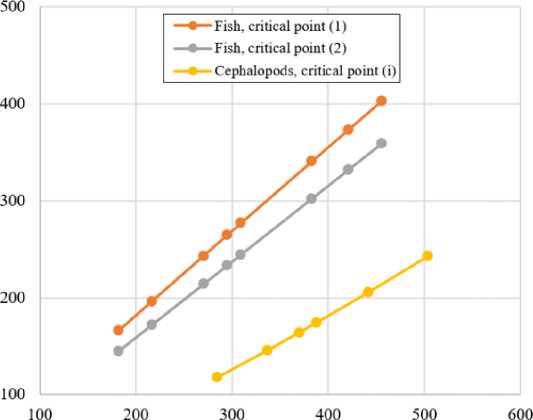
coe (dry weight), %
Fig. 6. Critical moisture dependencies on the initial moisture of hydrobionts ( source: compiled by the authors )
Рис. 6. Зависимости критических влажностей от начальной влажности гидробионтов ( источник: составлено авторами )
Therefore, in engineering calculations, when designing optimal modes of fish and cephalopods dehydration, it is necessary to use different equations for calculating critical moisture. Cephalopod’s dehydration treatment includes the period of constant drying rate proceeds more intensively than fish. The period is characterized by higher moisture losses over an equal period under identical conditions and comparable initial moisture of raw materials.
The scientific novelty of the work includes obtaining general patterns of dehydration processes during heat treatment of squid and octopuses.
The assumption about the possibility of generalizing the partial curves of the cephalopods dehydration kinetics under different modes of thermal processes was confirmed. Many curves of cephalopods dehydration are summarized in one generalized relationship and its mathematical description is proposed. Based on the analysis of the research results, it is highly necessary to use different equations in the calculation of critical moisture. The data presented in the work confirm that the period of constant drying rate which cephalopods have is more intensive than fish do. The period is characterized by higher moisture losses for an equal period under identical conditions and comparable initial moisture content of raw materials. This should be considered in engineering calculations when designing optimal resource and energy saving processes for cephalopods and fish dehydration.
Dependencies (1–3) indicate that the critical moisture is a function of the initial moisture. At the same time, the durations of reaching critical moistures in conjunction with the latter are the coordinates of critical points on the drying kinetics curves. The critical points show the dependence of the dehydration rate on the rigidity of heat treatment, the size and mass parameters of the dehydrated material, its chemical composition and properties. Therefore, the use of simplex criteria like
τ i τ i τ i
T ki ’ T k 1 T k 2
^^, ra i -M i for computational and analytical ® ki ® k 1 ® k 2
modeling of dehydration processes ( Glazunov et al., 2013; Pokholchenko et al., 2015 ), simple mathematical dependencies are given for modeling the required modes in design activities with the identification of the kinetics curves by calculation.
The results of mathematical processing of experimental data have shown sufficient reliability and adequacy of mathematical models (3–7) for their use in engineering calculations of processes and devices of food production.
In order to apply the generalized dehydration kinetics curve in engineering calculations, it is necessary to know the duration of reaching the critical moisture co k . Considering that the process of dehydration to the first critical point proceeds at a constant rate of dehydration and is linear in nature, the equation can be used to calculate the duration of reaching critical moisture ( Glazunov et al., 2013; Pokholchenko et al., 2015 )
= OL-OtL N
where N is the rate of dehydration to the first critical moisture.
The rate of material dehydration to the first critical moisture generally determines the nature of the process. For each thermal process under research, empirical equations ( Ershov, 1992; Glazunov et al., 2013; Pokholchenko et al., 2015 ) for finding the rate of dehydration to the first critical moisture are determined on the basis of partial curves of the dehydration kinetics, as functional dependencies on the parameters determining the process.
For the processes of cephalopods heat treatment, the following range of criteria is specified:
-
– infrared drying process
N = f К -, x j, (9)
I m J where o0 is the initial moisture content of the raw material; S/m is its specific surface area (in a particular case, the specific load of the food material on the carrier can be indirectly taken into account); ХIR is the rigidity of the heat treatment mode (combines the influence of the power of infrared emitters);
-
– the process of blanching in vegetable oil
N = f bo, -,To I,(10)
к m J here To is the temperature of the working medium (vegetable oil);
-
– the process of semi-hot drying by convective method
( -A
N = f ho,-,T,Ф,v I,(11)
к m here the T и φ are the temperature and relative humidity of the drying agent in the chamber; v is the circulation rate of the drying agent in the circuit, m/s.
Taking into account the different nature of the cephalopods and fish raw materials dehydration processes, it is reasonable to use the proposed mathematical dependencies (3–8) for the cephalopods while designing optimal heat treatment modes for various methods of energy supply. The applying the dimensionless criteria-simplexes in generalizing the patterns of thermal processes of food capillary-porous colloidal materials dehydration with similar internal structure and properties, allows to obtain adequate and uncomplicated mathematical models for their use in engineering calculations.
Conclusion
It has been proved that during the dehydration of cephalopods there is one critical point due to the corresponding structure of the tissues of capillary-porous colloidal material. A mathematical expression is obtained for finding the critical moisture during dehydration of cephalopods.
Analysis of the research results confirmed the necessity of using different mathematical dependencies for calculating critical humidity in engineering calculations while designing dehydration modes for fish and cephalopods.
The possibility of generalizing the kinetics curves in cephalopods dehydration with different methods of energy supply is confirmed.
Similarity simplexes have been offered that make it possible to reduce many kinetic dependencies of cephalopods dehydration with different size, mass and chemical composition under different process parameters into one generalized dependency.
A range of criteria for calculating the dehydration rate for various methods of cephalopods heat treatment has also been worked out.
Cephalopods after dehydration under different conditions of heat treatment were sent to the manufacture of food products (canned food, cooking, snacks), shown in Fig. 7.
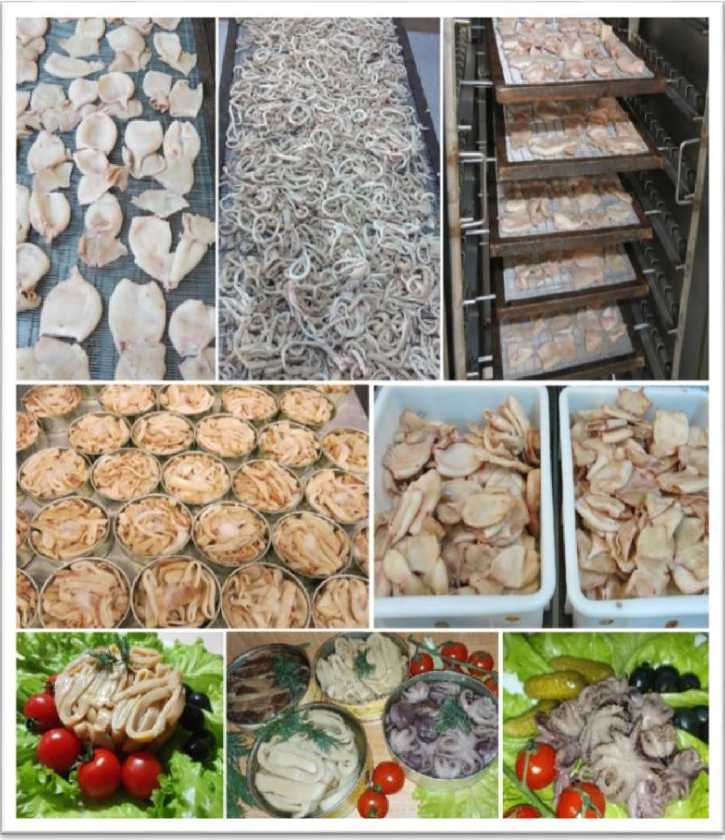
Fig. 7. Dehydrated semi-finished product and finished products from cephalopods ( source: compiled by the authors ) Рис. 7. Обезвоженный полуфабрикат и готовая продукция из головоногих моллюсков ( источник: составлено авторами )
New scientific results obtained in research of cephalopods dehydration processes can be used in the development of industrial technologies and techniques for dewatering aquatic biological resources with a unique opportunity to choose optimal modes analytically based on generalized dependencies, without additional costs for time-consuming research.
Conflict of interest
The authors declare no conflicts of interests.

